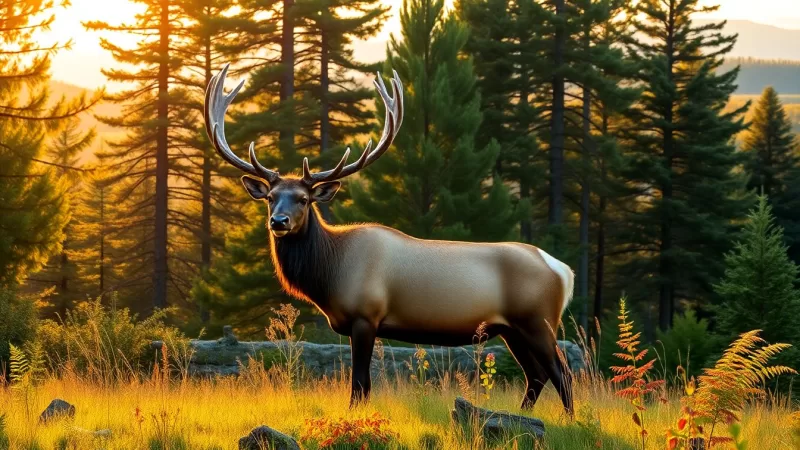Wapiti or Elk (Cervus canadensis): Extirpated from Massachusetts

Introduction
Imagine seeing a tall, majestic animal roaming open forests—an elk, called wapiti by some, a symbol of wild North America. These large members of the deer family once roamed across vast stretches of the continent, including Massachusetts. But today, they are gone from the state, wiped out for more than a century. Understanding why elephants of the forest disappeared from Massachusetts helps us learn about our land’s past and the need for conservation.
This article explores the history of elk in Massachusetts, the reasons behind their disappearance, and what might happen if these powerful animals return. It’s a story of ecological change, human impact, and hope for restoring our natural landscapes.
The Historical Presence of Elk in Massachusetts
Range and Habitat of Elk Historically in the Region
Long before towns and roads, Massachusetts was mostly dense forests with plenty of open areas filled with grass and shrubs. Elk thrived in the region’s woodlands, wetlands, and clearings. They preferred places with food, freshwater, and space to roam. In those days, their home extended beyond the mountains, crossing the Connecticut River Valley and spreading into areas now covered by cities.
Evidence of Elk in Massachusetts History
Archaeologists have found bones and tools that suggest elk roamed in the region thousands of years ago. Early settlers and Native Americans often described seeing large, impressive animals like elk. Their accounts mention elk tracks, hunting stories, and even myths involving these animals. These records prove elk were once an integral part of Massachusetts’ wildlife.
Decline and Extirpation Timeline
Elk numbers started falling in the 1600s as Europeans arrived. The combination of hunting, land clearing, and changing land use pushed their numbers down. By the late 1800s, sightings became rare, and most experts agree the last wild Massachusetts elk disappeared around the early 1900s. Their decline was linked closely to America’s rapid growth and expansion.
Causes of Extirpation in Massachusetts
Overhunting and Commercial Poaching
Hunting was the biggest threat to elk. In early days, elk were a prized game animal, providing food and hide. As hunting became more organized, elk populations declined fast. Commercial hunting and poaching meant fewer animals survived each season. Restrictions and conservation laws came too late to save most herds.
Habitat Destruction and Land Use Changes
Massachusetts saw mountains of land cleared for farms, towns, and roads. Forests shrank, wetlands drained, and open spaces vanished. Elk needed large areas of forest and grassland to thrive. As these habitats disappeared, they had nowhere to go. This habitat loss made it impossible for elk to survive and reproduce.
Competition and Predation
Introduction of new predators like coyotes and increasing numbers of deer increased competition for food. Elk struggled to find enough trees and plants to eat. These new pressures added to the stress that pushed elk towards extinction locally.
Ecological Impact of the Extirpation
Effects on Local Ecosystems
Elk are no small players; they shape their environment. Without them, forests can become overgrown, and certain plants may disappear. Their grazing keeps plant succession in check, creating habitat for many other animals.
Impact on Biodiversity
When elk vanished, the balance in local food chains shifted. Predators that hunt large herbivores lost a food source. Other species of deer and smaller animals also felt this change. Over time, the entire ecosystem was affected by the elk’s absence.
Lessons from Other Regions
Places like Yellowstone National Park show what happens when elk are reintroduced. They restore balance, improve plant diversity, and bring back wildlife. These success stories highlight how ecosystems benefit from the return of these animals, even after long absences.
Current Status and Efforts Concerning Elk in Massachusetts
Present-Day Elk Populations in Nearby Regions
Though Massachusetts lost its elk, neighboring states like New York and New Hampshire still have small herds. These regions attract visitors eager to see wild elk, and they serve as pockets of the species in New England.
Reintroduction Projects and Conservation Strategies
Reconsidering elk return to Massachusetts has gained support. Groups advocate restoring elk through carefully planned reintroduction projects. Agencies like the Department of Fish and Wildlife are researching how best to do this without disrupting current land use.
Challenges and Considerations
Reintroducing elk isn’t simple. The main hurdles include finding enough suitable land, preventing conflicts with human activities, and ensuring the public supports the plan. Regulations must balance ecological benefits with safety and landowner interests.
Prospects and Potential for Reintroduction in Massachusetts
Ecological Benefits of Reintroduction
Bringing elk back could boost local biodiversity and help restore natural processes. They could help control overgrown plants, open up habitats, and create better conditions for other wildlife. Reintroduction might even attract eco-tourism, bringing new income and awareness.
Feasibility Studies and Expert Opinions
Many scientists agree reintroduction is possible with proper planning. Studies suggest that with enough large protected areas, elk could thrive again. Other regions provide proof — if done right, elk can adapt and flourish.
Actionable Steps for Stakeholders
To make elk reintroduction possible, land protection and corridor creation are vital. Supporting policies that fund habitat preservation is essential. Engaging communities through education and outreach will build support for this natural revival.
Conclusion
Elk once roamed freely across Massachusetts, shaping the land and enchanting those who saw them. Their decline was driven by human actions like hunting and habitat destruction. Today, their absence affects local ecosystems and biodiversity. Reintroducing elk offers a chance to restore balance, bring back the natural beauty, and reconnect with our land’s wild roots. By working together—scientists, agencies, and communities—we can help bring the wapiti home once more. Reclaiming these giants can be a step toward a healthier, more vibrant Massachusetts.

